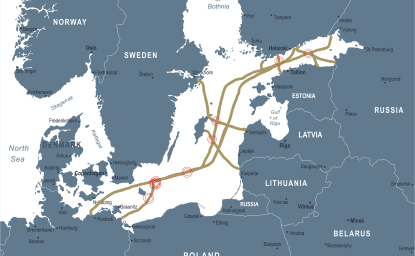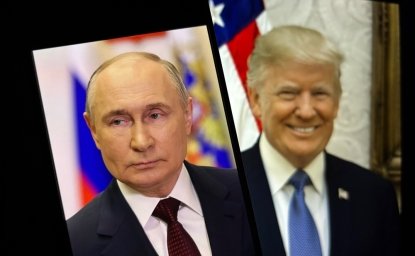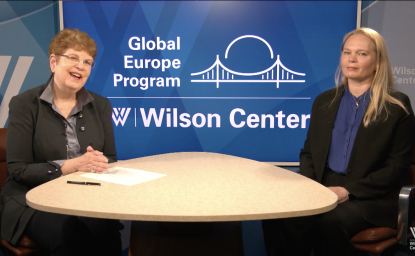336. Democracy and Donor Funding: Patterns and Trends


Andrew Green is an independent scholar. He is an alumnus of EES's Junior Scholars' Training Seminar and a recipient of an EES short-term scholar grant. He spoke at an EES Noon Discussion on February 21, 2007. The following is a summary of his presentation. Full reports associated with this study are available at www.DGMetrics.net. Meeting Report 336.
My recent research on donor funding for democracy development and civil society in European postcommunist states uncovers important differences in donor approaches and the key role played by non-state donor organizations. This research examines assistance for democratic development in postcommunist Europe for 1990-2004, with particular attention to funding for civil society. The purpose of the research was to examine trends and patterns of civil society funding from donors in order to gain insights on how such assistance may have shaped civil society, how it may be changing, and what we may see in the future. Data on other democracy and governance assistance was collected as well, because civil society assistance does not exist in a vacuum and its mix in overall assistance for democratic development is also important. More importantly, the project goes beyond the traditional focus on official donor agencies to examine private and quasi-private organizations. The data collected reveals that the distribution of funding priorities and the changing mix of assistance may foreshadow trouble for civil society in many of these countries.
The donors included in this study were official bilateral donor agencies such as USAID, the UK's Department for International Development (DfID), and the Swedish International Development Agency (SIDA); the EU itself (as opposed to the separate treatment of individual Members' activities); political foundations, such as the National Endowment for Democracy (NED) and the Westminster Foundation for Democracy; prominent private foundations such as Ford, Mott, and the Open Society institutions; and public-private ‘legacy' foundations such as the Baltic-American Partnership Fund, the Trust for Civil Society in Central & Eastern Europe, and the Balkan Trust for Democracy, created with combinations of private foundation and official donor agency funding.
Data are for all postcommunist Europe countries with the exception of Russia. Regional groupings were created for Northeastern Europe, Central Europe, Southeastern Europe and European Former Soviet Union. Slovenia was placed in the Central Europe regional grouping because of EU accession timing. The primary source of data is the OECD Development Assistance Committee (DAC) Creditor Reporting System (CRS), which all official donor agencies report to annually in accordance with activity classification standards. The data for USAID is taken from the Green-Richter database of USAID budgets and activities, which is a more accurate and fine-grained data source than what was reported by the agency to CRS. Data for political foundations was compiled based on a reconciliation of the NED's website, a dataset kindly provided by James Scott, and Westminster annual reports, while private and ‘legacy' foundation data came from annual reports kindly provided to me by the grant-giving organizations.
I coded all activities according to CRS categories, based on additional consideration of the funder's own classification, program title and additional text details. CRS includes a ‘Government and Civil Society' category with many subcategories. I included all subcategories in the dataset initially, and then reviewed additional information to determine whether an item needed to be reclassified. Security-oriented subcategories (such as landmine clearance, demobilization, post-conflict peace-building, and civilian peace-building and conflict prevention) were excluded from this analysis. The subcategories used for analysis are: (1) a ‘society-oriented' group that includes civil society strengthening, elections, free flow of information, and human rights, which are aimed at improving the capability of individuals and private organizations to interact with the state; and (2) a ‘state-oriented' group that includes government administration, legal and judicial development, and public sector financial management, which are aimed at reforming or assisting state institutions and their ability to interact with society.
Different approaches by donor
Looking at distributions of democracy assistance across categories (See tables 1 and 2) provides interesting insights on donors' reform priorities. From 1990 to 2004, the US government was clearly the largest source of democracy and governance assistance, although it should be noted that in the second half of the time period, the EU has at times been the larger donor due to funding for EU accession candidates. More surprising is the strong presence of the Open Society Institute and the Mott Foundation, both of which are private actors but comparatively more active than many traditional bilateral donors.
Table 1 [all figures in 000,000]
Country Society-Oriented State-Oriented Total
United States 1,117 970 2,087
EU 147 1,018 1,165
Open Society 310 109 419
Sweden 148 173 321
Norway 158 49 207
Netherlands 76 129 205
United Kingdom 26 142 168
Canada 60 57 117
Mott 97 2 99
Germany 34 62 96
The first table highlights different approaches to assisting democratic development, seen in the distribution of funding between society-oriented and state-oriented activities. The US has a slight inclination toward society-oriented programs, although the figures for state-oriented support are skewed somewhat by significant increases since 2001 for counterterrorism, security and other law enforcement programs. EU programs, on the other hand, are overwhelmingly state-oriented, which is not unexpected given the EU's interest in improving a state's institutional capacity prior to accession. What is more interesting is that the US pattern is found among other non-EU members such as Norway, Canada and private foundations, while the EU pattern is found among the other EU members. But what may be most striking to many is the dominant role played by private foundations, particularly the Open Society Institute.
Table 2 [all figures in 000,000]
Country Civil Society Elections Free Flow Info Human Rights Total
United States 702 195 188 31 1,117
Open Society 111 165 35 310
Mott 90 2 2 3 97
Sweden 69 8 14 57 148
EU 68 6 10 63 147
Norway 45 3 8 102 158
NED 45 10 19 6 79
Canada 44 8 1 6 60
Ford 26 2 15 42
Netherlands 24 5 27 21 76
The second table provides details within the society-oriented group of donors, which offer a better understanding of the priorities and approaches among the major donors. It is important to keep in mind that some of the patterns seen are due to informal donor coordination and comparative advantages. The US is again the largest among the official donor agencies, with Norway, Sweden, and the EU next but far below. US assistance not only focuses more on society than state institutions, but in the context of the postcommunist transitions focused on promoting the development of civil society. The active approach taken by Norway and Sweden—and to a lesser but marked extent by the Netherlands and Canada—could also be viewed as a manifestation of state priorities. The Johns Hopkins Comparative Nonprofit Sector Project (www.jhu.edu/cnp) offers some insight into donors' diverging priorities: Norway and Sweden have a long history of supporting human rights, while the Netherlands has been a strong supporter of independent media in the Balkans, and all four states have large civil society sectors. Among the top ten are four non-state organizations, in fact the second largest donor was the set of Open Society Institutes, with Mott and NED outpacing two major official donors.
The list of top donors in each of the society-oriented subcategories is quite revealing. Open Society and Mott are the next largest civil society donors after the US, and Open Society is the second largest donor of free flow of information programs. Open Society's focus on those two programming areas is to be expected given the ideological basis of its activities. The Mott Foundation is especially noteworthy for its concentration of funding in civil society, a programmatic strength of the organization that was strategically applied in Central Europe. NED, a political foundation supported by the US government, provides direct funding to the four core institutes (IRI, NDI, CIPE, ACILS), but in addition funds a wide variety of society-oriented activities. For its part, Ford has a long history of supporting human rights, public law and civil society development.
The data also show how funding is distributed regionally according to perceived need. Northeastern Europe assistance was dominated by Swedish aid (overwhelmingly state-oriented), followed closely by Open Society, and then the US and the ‘legacy' Baltic-American Partnership Fund. Assistance to Central Europe was dominated by the US, Open Society, the UK (overwhelmingly state-oriented), and Mott. Programs in European Former Soviet Union states were funded mostly by the US, Open Society, and Sweden. It is funding in Southeastern Europe where we see a different pattern in response to the various Balkan conflicts: there, the US is still the largest donor, followed by the EU, Open Society, the Netherlands and Sweden.
A changing mix over time
How the mix of programs, regions and donors changed over time is also informative. The society- and state-oriented groups tracked very closely each year except for a slight increase in state-oriented funding at the end of 1990s and a large jump after 2002, both of which are largely attributable to EU funding increases for EU accession candidates.
Looking at the top donors overall, the US was the largest donor until 2003, when the EU took the lead. When we look at the orientation groupings, however, a different pattern emerges. Although the US remains the largest donor for society-oriented activities and the EU is never even the second largest; for state-oriented activities, the EU and the US trade the top two positions frequently, with the EU dominating since 2003. With respect to civil society funding, the US is the largest donor even compared to the EU and all EU members combined. In terms of longevity, only the US, the UK, Sweden, Canada, NED and the private foundations were actively engaged on a meaningful level before the mid-1990s. Indeed, even increased funding levels from the non-EU states are not seen until 2001 or later.
It is the activities of the private and ‘legacy' foundations that are most striking. Looking at how the donor type changed over time shows that these organizations often either continued their lead role or stepped up their efforts as official donor agencies closed out activities. For example, when donors began leaving the Baltics and then Central Europe, Mott and the Open Society institutes dramatically increased their civil society efforts, joined in time by the ‘legacy' Baltic-American Partnership Fund and Trust for Civil Society in Central & Eastern Europe. Ford's notable efforts in support of human rights and legal reform run throughout the time period, split between Central Europe and a more general regional effort.
Among the smaller of the top donors, the Netherlands has maintained a focus on human rights and legal development, a comparative advantage for this EU Member state. Its programming has been spread across all regions, with a somewhat greater emphasis on Southeastern Europe. Norway's support for human rights and legal development has been overwhelmingly focused on Southeastern Europe and at a regional level. A concentration of funding in Southeastern Europe can also be seen in the remainder of the smaller top donors.
Implications for future impact and assistance strategies
There are three main findings and one troubling implication to take away from this new dataset. First, the dominance of democracy assistance by the US is unmistakable, particularly for society-oriented activities generally and civil society specifically, where it accounts for more than half of the assistance from top donors. Going further, though, US-based or US-networked organizations extend the dominance to more than 70 percent of society-oriented funding and 80 percent of civil society funding.
Second, the state-oriented approach and assistance timing of the EU and Members is equally unmistakable. Funding from the general set of EU donors has been targeted at improving state institutions in preparation for EU accession. This is neither better nor worse than society-oriented funding, but it does point to a fundamentally different approach in developing and deepening democracy. It should be noted that among the EU members on the list of top society-oriented donors, the UK is the original home of Euroskepticism; Sweden joined the EU only in 1995 and has resisted the Euro and the proposed constitution; and the Netherlands has been increasingly concerned about the EU's relatively less-liberal perspective on individual rights.
Third, private and ‘legacy' foundations have unquestionably played a critical role in democratic development in these states. From the Ford Foundation's support for public law to the Mott Foundation's support for civil society, to the Open Society Institute's support for both free flow of information and civil society, it is hard to imagine what these postcommunist societies would look like if not for the efforts of the private foundations. Indeed, in Central Europe, Mott and the Open Society Institute accounted for about 45 percent of total civil society funding. The ‘legacy' foundations continue much of this important activity today.
There is one troubling implication for the future, however, focusing on civil society. Recall from above that that over 80 percent of civil society funding came from the US and US-based or US-networked organizations, and then consider further the civil society funding from the UK and Canada, and it seems prudent to assume that the civil societies that developed were heavily influenced by an Anglo-American model of entrepreneurial advocacy organizations. EU funding for new members and candidate countries envisions civil society involvement, but the organizations that would qualify for such funding would almost certainly be service-providing organizations rather than government oversight or advocacy organizations. As funding from these donors for one sort of civil society organization winds down, funding from the EU that flows to a different sort is picking up, and so we are left with an important question: what will happen to the government oversight and advocacy organizations? Advocacy organizations are more reliant on philanthropy and revenue-producing economic activity, and tend to be excluded or ignored in public sector support. Unfortunately, as the Johns Hopkins Comparative Nonprofit Sector Project points out empirically, philanthropic giving is almost never a large source of funding for civil society sectors, so we need to think beyond our misconceptions. Advocacy organizations will have to develop new sources of funding, whether from revenue-producing products and services or (more remotely) state contracts. Some of the postcommunist states have developed indigenous sources of funding for foundations or advocacy organizations, including set-asides from privatization, percentages earmarked by individual taxpayers, and sin-tax proceeds, and for each region there is a ‘legacy' foundation that could provide support during this critical period.
There promises to be a ‘market shake-out' among advocacy organizations in postcommunist EU member states and candidate states, but that is not in and of itself a bad thing. What would be a serious problem for democratic development, however, would be the decimation of advocacy groups. A recent article by Steven Finkel, Anibal Perez-Linan and Mitchell Seligson in World Politics on democracy assistance shows not just a measurable impact of that assistance, but more specifically the impact of civil society, media and election funding. When we think about democratic development and the role of assistance, we must be mindful of longer-term trends, donor priorities and approaches, the impact of private and quasi-private organizations, and the key stopgap role that could be played by ‘legacy' foundations.

The Global Europe Program is focused on Europe’s capabilities, and how it engages on critical global issues. We investigate European approaches to critical global issues. We examine Europe’s relations with Russia and Eurasia, China and the Indo-Pacific, the Middle East and Africa. Our initiatives include “Ukraine in Europe”—an examination of what it will take to make Ukraine’s European future a reality. But we also examine the role of NATO, the European Union and the OSCE, Europe’s energy security, transatlantic trade disputes, and challenges to democracy. The Global Europe Program’s staff, scholars-in-residence, and Global Fellows participate in seminars, policy study groups, and international conferences to provide analytical recommendations to policy makers and the media. Read more



